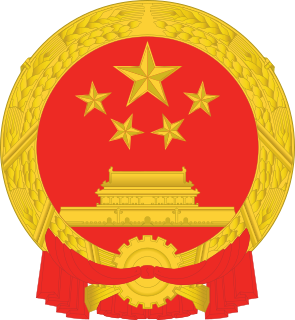
Wuhan University is in Wuhan, Hubei. It is one of the most prestigious and selective universities in China, which has been selected as a Chinese Ministry of Education Class A Double First Class University. It was one of the four elite universities in the republican period and also one of the oldest universities in China. In 1948, University of Oxford in the United Kingdom wrote to the Ministry of Education in China, confirming that undergraduate students at Wuhan University with degrees in liberal art and science, who had an average grade above 80 would be awarded "the senior status of Oxford". Wuhan university is located at Luojia Hill, with palatial buildings blending Chinese and Western styles. It is regarded by many as one of the most beautiful campuses in China.
Zhao Jiuzhang, also known as Jeou Jang Jaw, was a Chinese meteorologist, geophysicist and space physicist and engineer. He was a pioneer of Chinese space technology and is considered as a founding father of China's satellite program.
Beijing No. 8 High School is a public beacon secondary school located in Xicheng District, Beijing, People's Republic of China. The school was accredited as "Municipal Model High School" by the Beijing Municipal Commission of Education. It is a model school for Scientific and Technological Practice, a member of the Association of Youth Technology Education, a National Established School of Sports in Beijing, a Member School of the Chinese Radio Sports Association and a member of the Jinfan Orchestra. As the Olympics approached, the school improved its stadiums and was chosen as the training place for trampoline and swimming athletes, the only school to undertake two missions at the same time. The school's stadiums are now available to the public, including a standard soccer field, a 400-meter runway, an underground running training center, a swimming pool and several standard basketball fields. In recent years, there are about 40 graduates every year admitted to Peking University and Tsinghua University. This number accounts for nearly one-fifth of graduates each year. The overall college admission result ranks in the third place in Xicheng School District.
School of Aeronautics and Astronautics (SAA) of Zhejiang University, is one of the university schools/colleges primarily focuses on space technology in the People's Republic of China.
Zhejiang Provincial College of Medicine, was a medical college for higher education in Hangzhou, Zhejiang Province, China. It was one of main roots for the current School of Medicine, Zhejiang University (浙江大學醫學院/浙江大学医学院).

Jiangnan University, is a university located in Wuxi, Jiangsu, China. It is a key national university of the “Project 211” and is directly administrated by the Chinese Ministry of Education. It is also a Chinese Ministry of Education Double First Class Discipline University, with Double First Class status in certain disciplines.

North University of China is a university based in Taiyuan, Shanxi province, China. It was formerly known as North China Institute of Technology from 1993 to 2004. Founded on September 8, 1941 as Taihang Industrial School, and renamed Taiyuan Institute of Machinery in 1958, the university played an important role in the weaponry development and personnel training for the PLA during the Second Sino-Japanese War and the Chinese Civil War. In 2001, senior Party official Bo Yibo wrote the inscription "The First School for People's Ordnance" (人民兵工第一校) at the 60th anniversary of the university.
Ho Ping-sung, 1890–1946, was a notable Chinese educator, writer and historian.
Chen Ziyuan is a Chinese agricultural scientist, educator, and main founding father of China's nuclear agriculture.
WXIT UAV is a Chinese UAV developed by Wuxi Institute of Technology (无锡职业技术学院) and has entered service in China for aerial cinematography and photography missions.
China International Technology Transfer Center (CITTC), is a platform set up by the Ministry of Science and Technology of the People's Republic of China, the Beijing Municipal Commission of Science and Technology and the Haidian District Government. It is devoted to promote and facilitate global technology transfer between universities, research centers, science parks, competitive clusters, public organizations, as well as the Chinese industry.
Duan Shumin is a Chinese neuroscientist. He completed his undergraduate and Masters degrees at Bengbu Medical College, and his Ph.D from Kyushu University. Then he did his postdoctoral research at University of Hawaii and University of California, San Francisco. From 2000 to 2009 he served as a principal investigator in Institute of Neuroscience in Shanghai, Chinese Academy of Sciences. He was elected a member of CAS in 2007, and of TWAS in 2008.

The Double First Class University Plan or Double Top University Plan is a Chinese government plan conceived in 2015 to comprehensively develop a group of elite Chinese universities and individual university departments into world class universities and disciplines by the end of 2050.
Hangzhou No. 2 High School is a coeducational public secondary school in Hangzhou, Zhejiang, China. It has more than 2,800 students, aged 16 to 18 years. It was founded in 1899 by American Christian missionary W. S. Sweet. The school has gained prestigious reputation in many aspects, often referred to as one of the "three top high schools" in Hangzhou.
Li Xudan was a Chinese human geographer born in Jiangyin, Jiangsu Province.
The Wuzhen Theatre Festival is an annual theatre festival held in Wuzhen, Zhejiang, China. It is jointly sponsored by Stan Lai, Chen Xianghong, Meng Jinghui and Huang Lei, and hosted by Culture Wuhan Co., Ltd. The festival includes units of Specially Invited Plays, Youth Theatre Artists Competition, Outdoor Carnival, and Wuzhen Dialogues.













